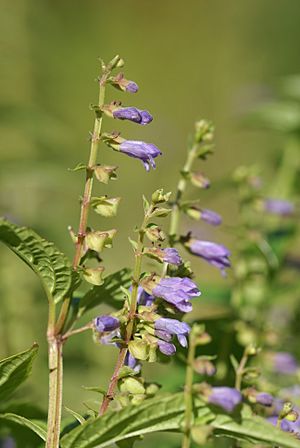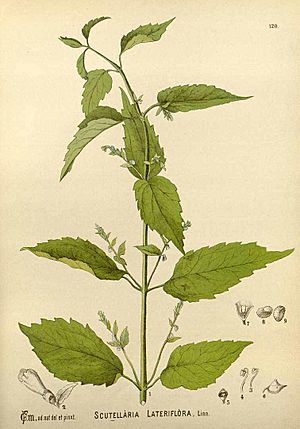Scutellaria lateriflora facts for kids
Quick facts for kids Scutellaria lateriflora |
|
|---|---|
 |
|
| Conservation status | |
| Scientific classification | |
| Genus: |
Scutellaria
|
| Species: |
lateriflora
|
Scutellaria lateriflora, often called blue skullcap or mad dog skullcap, is a tough plant that comes back every year. It's a type of herb in the mint family, and it grows naturally in North America.
This plant usually stands tall, growing about 60 to 80 centimeters high. It loves wet places, so you'll often find it near marshes, wet meadows, and other damp areas. Its blue flowers are small, less than a centimeter long. Most of these flowers don't grow at the very top of the main stem. Instead, they appear along the side branches that grow from where the leaves meet the stem.
Contents
Traditional Uses of Blue Skullcap
People have used blue skullcap in herbal medicine for a long time. This plant contains natural substances called flavonoids. Other similar skullcap plants, like common skullcap (S. galericulata), have also been used for similar purposes.
Some people use extracts from blue skullcap as a mild way to help them relax or sleep better. It's important to know that sometimes, skullcap products have been mixed with other plants like germander (Teucrium canadense). These other plants can sometimes contain substances that might not be good for your liver.
Scientists are always studying plants like blue skullcap. For example, a substance called beta-elemene from the herb is being looked at in lab studies. However, we don't have enough studies in humans yet to confirm if it has any special effects.
What's Inside Blue Skullcap?
The leaves, stems, and roots of skullcap plants contain important natural chemicals called phenolics. Some of these include baicalin, baicalein, wogonin, and oroxylin A.
Baicalin, for example, has been shown to help with swelling and pain in studies using rats. Other studies have found different types of flavones in blue skullcap. These flavones might help with feeling anxious in rats.
The flavonoids are found all over the plant, but there are more of them in the leaves. As the plant gets older, the amount of flavonoids might go down a little. If you dry the leaves, they can have about 50 milligrams of flavonoid per gram. These flavonoids can be easily taken out of the plant using hot water.
Plant Parts and Chemicals
| Chemical | Amount (mg/g) |
|---|---|
| alpha-cubebene | 42 |
| alpha-humulene | 42 |
| beta-elemene | 92 |
| calamenene | 152 |
| delta-cadinene | 270 |
| Chemical | Amount (mg/g) |
|---|---|
| Carbohydrates | 780 |
| ascorbic acid (Vitamin C) | 1 |
| baicalin | 10 |
| scutellarin | |
| scutellarein | |
| tannin | 28-35 |
| wax | 12 |
See also
 In Spanish: Escutelaria de Virginia para niños
In Spanish: Escutelaria de Virginia para niños



